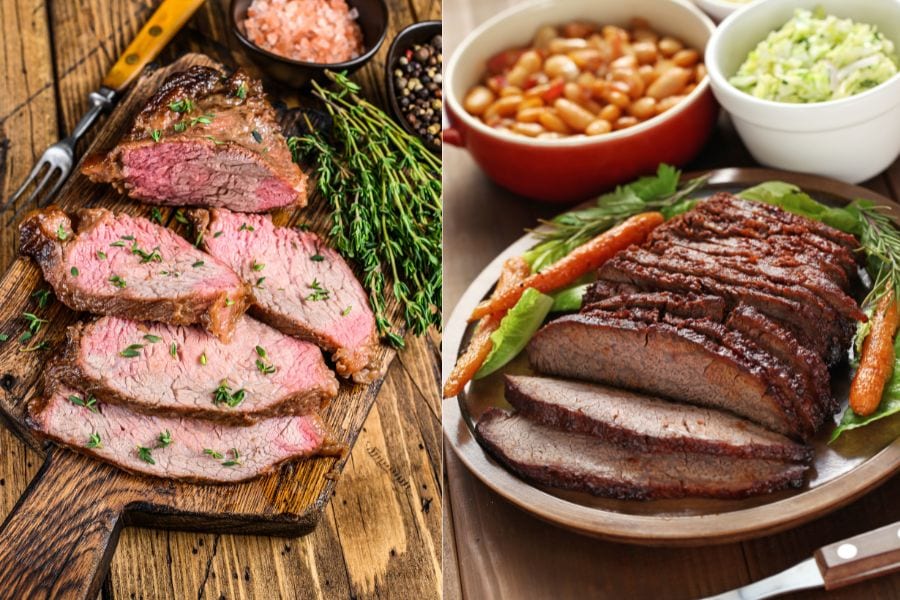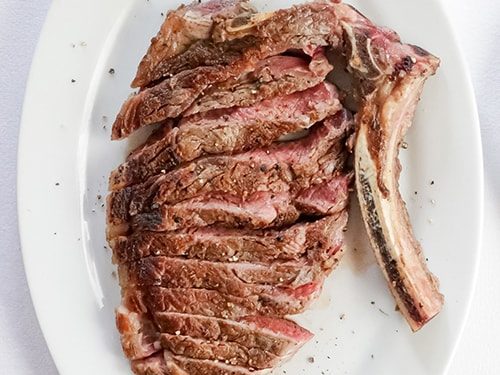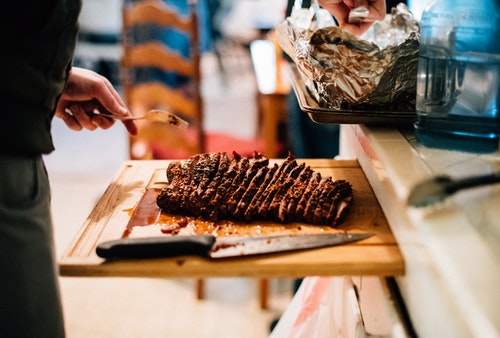When it comes to tri tip vs brisket, the differences include size, taste, methods of preparation, cooking times, and more!
In culinary school I was taught how to prepare both these cuts of meat and so I learned a fair amount about each of them. It is now time to pass on the baton.
In this post, I will outline how they vary from one another and even show you how to cook each option to perfection. Let’s begin!

This cut of meat is often referred to as a tri tip steak. It is taken from the tri tip roast cut, which is a part of the bottom sirloin subprimal. The tri tip cut is so named for its triangular shape.
Tri tips have been steadily getting more popular as it is pretty economical cut. To add to this, it is a lean cut with a decent amount of marbling. This makes it one of the more flavorful cuts, particularly at this price point.
If you are looking to buy tri tip, it can be a little tricky as it goes by so many different names. These include: Santa Maria steak, California cut, Newport steak, bottom sirloin butt, or a culotte steak.
Related Reading
Now, let’s take a look at what beef brisket is all about. Brisket is taken from the breast section of the cow, beneath th first five ribs and behind the foreshank. A whole brisket, also known as a full packer brisket, is made up of two incredibly tough muscles – superficial and deep pectorals.

The pectoral muscles of the animal gets a lot of exercise. As a result, this ends up being one of the least tender cuts of beef. A full brisket is typically divided into the flat cut and the point cut.
The flat is a lean cut that works well as corned beef. The point, on the other hand, has a nice fat cap. This makes for a juicy and tasty dish, especially when it has been smoked.
Related Reading
Here is a closer look at the main differences dividing tri tip and brisket:
Generally speaking, a full brisket can weigh anywhere from 10 to 16lbs – it can be even heavier than this. A flat will weigh around 6 to 10lbs, making the point the smaller portion. Briskets are typically prepared to cook for large groups. Pick a bigger cut and you can easily end up feeding dozens of people.
Unlike brisket a whole tri tip, untrimmed, will weigh in at about five pounds. However, it is quite unusual to find an untrimmed tri tip. As such, any cut that you buy may weigh 1.5 to 2.5lbs and be about 2 to 3 inches thick.
Typically, a single tri tip will feed about three to four people. Essentially, it works well for dinner for a small family.
Both brisket and tri tip are rather tasty cuts.
Tri tip cuts have the advantage of being the most flavorful cuts as is, though. They have a strong, beefy flavor and a nice chew. Interestingly enough, due to its fat content, there is also a lovely buttery flavor.
The beef flavor is quite notable here as well. What really brings out the flavor in brisket, though, is the way that it is prepared. When cooked properly, you end up with a delicious smoky flavor and a gorgeous crusty bark that is crunchy and dark.
Regardless of which one you choose, though, it is sure to be a winner thanks to their individual yet delicious flavor profiles.
One of the biggest differences with brisket and tri tip – apart from the size – is the cooking process.
See, when you cook tri tip it is all about cooking it on high heat, quickly. This is because the meat is so lean. Cooking it for too long causes it to dry out.
Grilling, pan searing, and broiling are the best ways of cooking tri tip. This cut of meat should only be prepared to medium rare or medium levels of doneness. Anything more than this and it is ruined.
Due to the fact that it doesn’t have too much fat, tri tip requires marinating – about two to three hours in a spice rub should do.
Then, there is the brisket. The most popular method of preparing this cut is to smoke a brisket. This cut of meat benefits from slow cooking. As mentioned, the meat can be incredibly tough. If you want it to be tender enough to enjoy, then it must be cooked on a low temperature for a longer period of time.
Now, smoking brisket isn’t your only option. In terms of the low and slow cook, braising and even using an Instant Pot can do the trick. However, I – and many others – am of the opinion that nothing can compare to a properly smoked brisket.
Although I have said that the best way to prepare tri tip is with quick cooking methods, it is possible to smoke tri tip. It is important, though, to not go over 225 degrees Fahrenheit at any point during the cook. Maintain this temperature so that you don’t overcook the meat.
So, which one is easier to cook? Hands down, it is the tri tip! It can be quickly prepared on the stovetop. Depending on how you prepare it, it will be done in less than half an hour. To add to this, you can use a method that you are already quite familiar with.
As much as I love brisket, I have to admit that it isn’t the easiest cut to master. For one thing, it can take up to twelve hours to cook, depending on the shape, size, and weight of the cut! Furtheremore, there are lots of various steps that you have to follow through on to ensure that it is cooked to perfection. The good news is that if you get it right, it makes for an incredible dish.
I would argue that the brisket is the more popular option, but not necessarily for the reason that you think. The issue is that it is difficult to find a whole tri tip. For one thing, there is a regional difference in how butchers cut this area.
Another problem is that this cut is fairly small and there is only two per animal. As such, even if your butcher did stock tri tips, they may be sold out fairly quickly. To add to this, there is a great deal of confusion surrounding what tri tip is. As it goes by so many names, it is possible that your butcher may not be familiar with the name that you call it!
When it comes to popularity and availability, brisket cuts are the clear winner here. For one thing, they are massive cuts of beef and can easily feed a lot of people, making them a profitable option for butchers.
There is also the fact that brisket is quite versatile. From pastrami to pot roast, the options are endless.
Of course, as more and more people learn how to cook a tri tip, this may begin to change.
Brisket takes the winning spot here, with the average being $4 to $5 per pound. This does depend on the grade of the meat as well as the cut. For instance, a flat may cost as much as $8 per pound, while a packer may only come in at around $3.

What makes a brisket even cheaper to buy, though, is the fact that you can feed so many people due to its larger cut.
This is unlike tri tip, whose price tends to be around $11 a pound. As there is not as much of this meat to go around, you end up paying a higher cost. And, the more that you buy, the higher that your bill will end up being.
Of course, it doesn’t make much sense for me to outline tri tip vs brisket and not show you how to make each cut of meat. So, here goes:
Now, with the tri tip, you have two options for seasoning – you can keep it short and simple with just kosher salt and pepper. Or, you can get fancy with it. If you are choosing the latter option, here is a great rub recipe to follow:
Mix this all together and store in an airtight container until you use it.
Trim the silver skin and some of the fat. Make sure to keep enough fat to add fat and flavor to the meat, though.
Sprinkle the rub on each side of the tri tip. Let it marinate anywhere from two hours to overnight in the fridge. Take the meat out of the fridge an hour before cooking.
Set the charcoal or gas grill to high heat. Place the tri tip on the grates and sear for 6 to 8 minutes. Then, flip over and sear for the same amount of time.
Lower the temperature to medium high or move the tri tip to an area of indirect heat. Cook for about 8 to 10 minutes before flipping over and grilling for the same amount of time. The meat is done when the internal temperature registers 130 degrees Fahrenheit.
Take the tri tip off the heat and then set it on a cutting board. Let it rest for up to 20 minutes. When this period is over, slice against the grain and serve.
For the brisket, your best bet is to keep the dry rub simple – salt and pepper is the way to go here.
You can use a charcoal smoker or an electric smoker. For wood chips, it is best to go with oak. This offers a nice, smoky flavor without worrying about going overboard. If you would like to experiment with other options, hickory or mesquite can be nice, but you should be warned that the flavors can be quite potent. Use very little of this wood to begin with.
Set the temperature to between 225 and 250 degrees Fahrenheit.
Place the brisket in the smoker. There can be a lot of debate about placing the brisket fat cap up or down – this all depends on where your heat source is. Make sure that the fat cap is facing this direction.
About two-thirds through the cook, the brisket reaches a temperature of between 165 and 170 degrees and stalls. Once the internal temperature registers this, take the brisket out of the smoker.
Next, wrap it in aluminum foil or butcher paper tightly. Place it back in the smoker and let it sit there until the temperature hits between 190 and 203 degrees Fahrenheit. It is then time to take the brisket out.
Let the brisket sit for about two hours before cutting and serving.
Related Reading
No, there may be more differences than similarities between these cuts, but I would not say that one is better than the other. They are pretty great in their own way. As long as you prepare them well you can ensure that they make an excellent meal!
Of course, there is a matter of personal preference. If there is one cut that you like more than the other, there is certainly nothing wrong with that. I would suggest giving each one a try, though. It will be worth it!
So, there you have it – the ultimate analysis! There is a whole lot to learn about these cuts of meat, but it is a fascinating journey. And, the more that you know, the better equipped you are to make each option. Not to mention, it is all pretty interesting to learn!